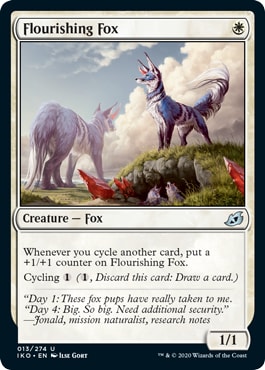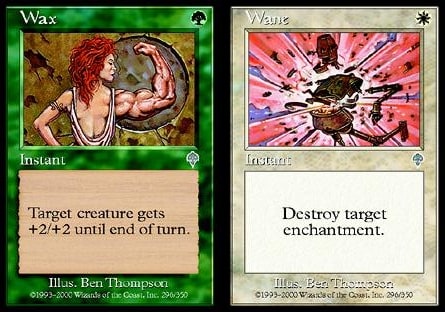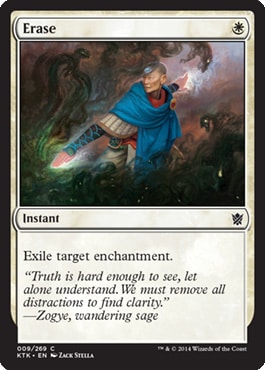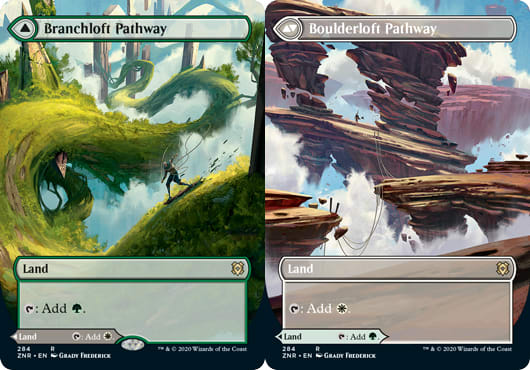Modal Double-Faced Cards represent an important design innovation. While players have seen many takes on "split" cards in the past - many of them worthy of Constructed consideration - Modal Double-Faced Cards challenge the age-old task of deck-building in a fundamental way.
Consider the following three cards:
Interestingly, these cards are all almost exactly as popular as each other. Essentially, they are all played as four-ofs in more-or-less exactly the same deck. Intuitively, if someone asked you which one was the best card and which one was the worst card... You would be able to easily answer at least the first question.
Flourishing Fox is the best of the three. The reason? The card provides almost peerless leverage if it appears in your opening hand. Of the three, it is the most legitimate "split" card... You generally want to play it as a 1/1 creature on turn one; and might want to play it as a 1/1 creature later, depending on what else is going on in the game. If you have Lurrus of the Dream-Den already in play, you might just cycle it first, though.
Go for Blood is played as a one-mana almost-Opt most of the time. Not all of the time... But certainly more than 50% of the time. That said, it is one of the only legitimate ways a Standard Cycling deck has to interact with opposing permanents in Game 1... So sometimes you play it as a removal spell. In this sense, it's hard to say what is more flexible, Flourishing Fox or Go for Blood. You want to play Flourishing Fox as a Fox the vast majority of the time, but you want to cycle Go for Blood merely most of the time.
By contrast you essentially never cast Boon of the Wish-Giver. Putting aside this card's potential emergence in non-Cycling decks, this is a card that you can't really cast if you're playing straight Boros. Imagine I had selected Frostveil Ambush instead. That card really never gets cast! But it's a very good Cycling card... Most of an Opt for not-necessarily-Blue mana.
Mechanically, a traditional "split" card, like this one (which was played by Pro Tour Champion Kai Budde in the greatest Pro Tour Top 8 of all time) is practically / thematically very similar to both cycling cards like Go for Blood and many Modal Double-Faced Cards.
Kai could play an Erase effect - even if it was a slightly worse Erase output for the "same" mana... And could get away with a worse Giant Growth in the case that the opponent didn't play enchantments at all. To be clear: This is a far, far worse Giant Growth than Giant Growth... But it mitigated the potentially dead draw of a bad erase to the point that Kai splashed a second color essentially only for it.
Is Go for Blood the best fight spell? It's not even the best fight spell in Standard!
For the same total converted mana cost, you can get a sick instant that brings the spirit of Searing Blaze to Green. But Go for Blood represents one of the most flexible cards in Boros Cycling precise because you aren't supposed to cast it most of the time.
I think that's the proper lens to evaluate Modal Double-Faced Cards. We know it's okay to play cards that are a little worse than non-split / non-flip / non-cycling analogues... As long as the insurance policy is also at least mostly palatable.
The difference with Modal Double-Faced cards is that the flip side - literally in these cards' cases - is almost always terrible... But maybe not so terrible you would never play them. That said, they might change the fundamental precepts of deck design. What does it mean for a Goblin Charbelcher deck to play no land cards at all? Only Modal Double-Faced ones? Can the presence of more "potential" lands make the current mulligan rule even more potent? Cycling cards, and even cantrips like Fire // Ice don't do that: You still need resources to draw extra. Whereas the back of a Modal Double-Faced card is the fundamental resource itself.
The Cycles
Broadly, there are three major models of Modal Double-Faced Cards (so far).
The Pathway cycle provides an untapped source of colored mana on one side... And an untapped source of a different color of mana on the other. Example: Branchloft Pathway
Not only will every land in this cycle likely prove Staple in Standard, they should all see play in formats at least as deep as Modern... And probably Legacy. For formats with fast aggro decks, it might be better to play a Branchloft Pathway on turn one to make your Noble Hierarch, or as Boulderloft Pathway sometimes setting up your Collected Company... But never, ever, take three damage breaking a Wooded Foothills into a Temple Garden.
More specifically, it seems to me that Cragcrown Pathway will be a game changer in Pioneer. Mono-Red is already a standout deck in that format, and the ability to more consistently splash Klothys, God of Destiny - maybe never exposing a second source of Green an entire long game - seems like an impending technology reboot for the format.
The Mythics give us flip sides that can come into play untapped... sometimes. The cost might be steep, but you'll often be okay paying it, especially in matchups where you would take more damage if the land entered the battlefield tapped.
Finally, there is everyone else. All the other land-sides - whether uncommon or rare - enter the battlefield tapped. In order to play any of these (and there are some worth playing), you'll really want to be able to wrap your arms around the spell-side.
White
Playable Cards:
In White, the only card I really imagine being truly unplayable is Makindi Stampede. I think if you want an Overrun it's one of those things where the effect is specific enough that you lean into it in order to get the best outcome. Despite calling itself a Stampede, Makindi Stampede lacks not only Overrun's third power boost but trample.
I actually think I prefer Rare Ondu Inversion to Mythic Rare Emeria's Call.
Don't get me wrong - I kind of never want either half of an Ondu Inversion. But at the same time, I'm a longtime advocate or aficionado of six mana Akroma's Vengeance-types. For some matchups, the difference between six and eight (say if you already have twenty) is trivial. And for the rest of them, playing a land (even if it's tapped) might keep you alive.
It takes a particular deck to be able to get paid on a Kabira Takedown... Just as Go for Blood is only good enough to play in one Standard archetype. Skyclave Cleric, on the other hand, is a legitimately workable sideboard card.
This is coming from someone who won-won a Regional Pro Tour Qualifier with 4x Omenspeaker in my sideboard!
Blue
Playable Cards:
Glasspool Mimic seems like an actively good card to me, for decks that are in the market for a Clone. It can't copy the opponent's creatures, but costing a full mana less is substantial.
Jwari Disruption is not good on either side. But Force Spike (same effect for competitive mana) is actually too good for Standard... And Quash has stolen plenty of lunch money since it's been legal. Including by Yours Truly. A card that's worse than both on the front side seems eminently good enough when combined with a land option.
I think you'll need a lot of redundancy to make Silundi Vision playable... But it's an instant, and certain combo decks might require just that much redundancy. At the same time, those decks occasionally would rather play lands than discard against Control. Peanut butter and chocolate.
Sea Gate Restoration on the other hand? I can't for the life of me imagine when I would want to cast thig. And for me to ever want to pay three life for Sea Gate, Reborn I'd need to want to cast it sometimes. I mean so much can go wrong with this. Like if you're in topdeck mode? Seven mana for one card? Costing a bazillion anyway? You don't even win the game immediately or anything.
Black
Playable Cards:
Agadeem's Awakening is the best of the bunch and the first of the Mythics that I'd really and truly want to play. I can see it being a four-of in some Black aggro decks, essentially pre-sideboarded against sweepers, or an insurance policy post-trading.
Blackbloom Rogue and Malakir Rebirth are really not that bad. One of them is a sometimes-Juggernaut for three! Juggernaut was once banned on power level. Malakir Rebirth has a lot of applications, and costs only one mana. It gets better when you're dealing with a 187 creature, but it's fine even when all you're doing is saving your best guy from a removal spell.
Hagra Mauling, though; is the gem of the color. Probably better in a control deck than a beatdown one, it's costed similarly to a bunch of cards that simply have better upsides (e.g. Vraska's Contempt or Hero's Downfall)... But, of course, has the best downside insurance.
Red
Playable Cards:
Shatterskull Smashing is probably the second best of the Mythics. It's simply a very good card, and can be played in a wide number of decks. Ask yourself this question: Is Shatterskull Smashing good in a Genesis Ultimatum deck?
Genesis Ultimatum is kind of difficult to cast. The ability to play Shatterskull Smashing as a Red-producing land - possibly untapped and on demand - might win the game! Though Genesis Ultimatum is not good at casting Shatterskull Smashing for free, it does cost seven; and will very likely put at least one land in play. Eight mana is when the Shatterskull Smashing that just went into your hand starts getting interesting. How convenient.
Spikefield Hazard is probably not good enough for Standard... But might be great in Modern or any deck that plays a lot of Monastery Swiftspears and Soul-Scar Mages. It costs the right amount of mana, and can potentially help a one-drop rich deck cheat on mana.
Green
Playable Cards:
The best of the group is clearly Kazandu Mammoth. I'd hazard it would have been a great preview card for me to get, rather than Murasa Brute. Though both are better than Gnarled Mass itself.
For its part, Kazamdu Mammoth is potentially an excellent card. Imagine it in concert with a fourth turn Fabled Passage... into a Migration Path. Imagine having two in play at some point.
It's fundamentally different than most Landfall Aggro creatures. It has a decent body at fail state; but can look really, really good.
Vastwood Fortification bears special mention just because anything that makes +1/+1 counters so cheaply and flexibly is potentially synergistic with the Hardened Scales or Winding Constrictors (or Standard analogues) of the world.
Not a fan of Turntimber Symbiosis myself - even in Amulet it seems a head scratcher - but it's difficult for me to call it out and out unplayable.
What is going to be interesting is not just which Modal Double-Faced Cards are playable in the abstract, but how deck with lots of them line up against decks without very many. I feel like, given sufficient time, "specialists" in Magic tend to beat out generalists. But it seems to me that adding lands - even if conditional - can muddy that original condition, about having enough time. It'll certainly be fun to watch these matchups unfurl.
LOVE
MIKE





























